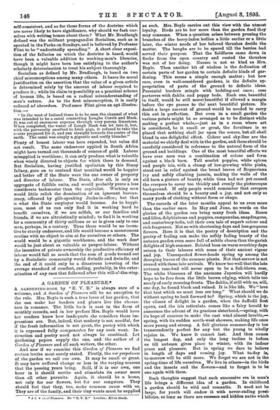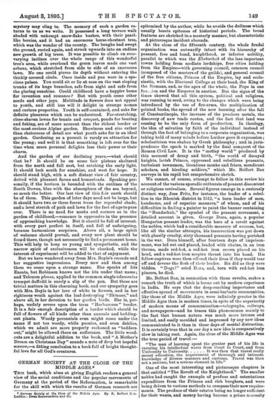A GARDEN OF PLEASURE.*
A GARDENING-BOOK by "E. V. B." is always sure of a welcome, and A Garden of Pleasure will be no exception to the rule. Mrs. Boyle is such a true lover of her garden, that she can make her borders and plants live like charac- ters in romance. The little book is cast in the form of monthly records, and in her preface Mrs. Boyle would have her readers know how inadequate she considers these im- pressions are. But, indeed, that modesty is not needful, for if the fresh information is not great, the poetry with which it is expressed fully compensates for any such want. In- struction and poetry need not always be combined. Let gardening papers supply the one, and the author of A Garden of Pleasure and all such writers, the other.
And now if we examine this Garden of Pleasure we find -certain truths most surely stated. Firstly, the ver perpeluum of the garden we call our own. It may be small or great. It may have suffered change or loss in the varying seasons that the passing years bring. Still, if it is our own, one -hour in it should soothe and stimulate its owner more than all other pursuits. Again, it should be a home, not only for our flowers, but for our songsters. They should feel that they, too, make common cause with us. They are of the family, and their tiny wants must be supplied • A C r en of PLeasurn. By 'R. V. B." London: Ell'ot Stock.
as such. Mrs. Boyle carries out this view with the utmost loyalty. Birds are to her more than the garden food they may consume. When a question arises between pruning the branches of the berry-laden hollies a little earlier or a little later, the winter needs of her beloved thrushes decide the matter. The boughs are to be spared till the berries had served their purpose. That the fieldfares came down in flocks from the open country and (mated the thrushes was not of her doing. Nature is not so kind as Mrs. Boyle. Then another bit of wisdom is the dedication of certain parts of her garden to certain definite kinds of gar- dening. This seems a simple enough matter ; but how rare, even in well-considered gardens, is the definite ap- propriation of parts of the ground to definite ideas. Perennial borders mingle with bedding-out ones ; rose parterres with dahlia and poppy beds. Each one, beautiful in itself, would be still morelbeautiful if allowed a margin before the eye passes to the' next beautiful picture. No doubt a large amount of ground would be needed to carry this out in perfection. But even in a small garden the various points might be so arranged as to be distinct while making a perfect whole,—just as in a room where art is considered, be it small or great, the furniture is so placed that nothing shall jar upon the senses, but all shall blend in one delightful effect. Colour and sly-line are the material we chiefly deal with in the garden, and these should be carefully considered in reference to the natural form of the ground and buildings. One of the most beautiful effects we have ever seen was a combination of colour and form against a black barn. Tall scarlet poppies, white spira3a and purple iris, with a clump of low-growing white pinks, stood out in relief against the broad leaves of Regneriana ivy and softly climbing jasmin, making the walls of the old barn a picture of beauty, while time had not yet caused the creepers to cover too thickly and evenly the picturesque background. If only people would remember that creepers themselves should be a beauty and a joy, and not only so many yards of clothing without form or shape.
The records of the later months appeal to us even more than the earlier ones. In May and June, no words on the glories of the garden can bring many fresh ideas. Roses and lilies, delphiniums and poppies, campanulas, snapdragons, and canterbury-bells, tell their own tale of superb colour and rich fragrance. Not so with shortening days and less gorgeous flowers. Here it is that the poetry of description and the poetry of feeling can make the softly fading beauty of the autumn garden even more full of subtle charm than the garish delights of high summer. Belated bees on warm sunshiny days return to their labours with some of their ancient vigour and joy. Unsuspected flower-heads spring up among the drooping leaves of the summer plants. Not that sorrow is not roused with these late arrivals. We know too well that the late autumn rose-bud will never open to be a full-blown rose, The white blossoms of the anemone Japonica will hardly hope to be free from the little brown edging, which tells too surely of early morning frosts. The dahlia, if still with us, will, one day, be found black and ruined. It is like life. We "love that best which we must lose ere long." What should we do without spring to look forward to? Spring, which is the joy, the climax of delight in a garden, when the daffodil first opens, and the iris reticulata comes like a fairy herald to announce the advent of its gracious sisterhood,—spring, with its hope of summer to make the east wind almost lovable; spring, with its sudden south-west showers, making life once more young and strong. A full glorious summer-day is too transcendently perfect for any but the young to wholly rejoice in. We know it cannot last, And then comes the longest day, and only the long incline is before us till autumn gives place to winter, with its indoor peace and pleasure. But in spring we dare to believe in length of days and coming joy. What to-day is, to-morrow will be still more We forget we are not in the spring-time of life ourselves. We live in others—in the birds and the insects and the flowers—and to forget is to be one again with them.
Such thoughts suggest that each successive era in man's life brings a different idea of a garden. In childhood a garden should be wild and romantic. It need not be large, for youth will endow it with never-ending possi- bilities, so lone as there are recesses and hidden paths which mystery may cling to. The memory of such a garden re- turns to us as we write. It possessed a long terrace walk shaded with unkempt snow-flake bushes, with their pearl- like berries, and it had an enormous horse-chestnut tree, which was the wonder of the county. The boughs had swept the ground, rooted again, and struck upwards into an endless new growth of big trees. It was possible to climb on ever- varying inclines over the whole range of this wonderful tree's area, while overhead the green leaves made one vast arbour, which stretched from side to side of an enormous lawn. No one could pierce its depth without entering the thickly covered circle. Once inside and you were in a spa- cious palace. You could sit or lie at ease on the vast sloping trunks of its huge branches, safe from sight and safe from the glaring sunshine. Could childhood have a happier home for invention and romance ? But with youth come other needs and other joys. Multitude in flowers does not appeal to youth, and still less will it delight in strange names and curious properties. Youth is self-contained, and asks for definite pleasures which can be understood. Far-stretching, close-shaven lawns for tennis and croquet, ponds for boating and fishing, are of more account than the richest border or the most curious Alpine garden. Showiness and size rather than choiceness of detail are what youth asks for in an ideal garden. Gardening as a pursuit is rarely an attraction for the young; and well it is that something is left over for the time when more personal delights lose their power or their charm.
And the garden of our declining years,—what should that be It should be on some fair plateau sheltered from the north and full east, but catching the early light. It should look south for sunshine, and west for hope. It should stand high, with a soft distant view of fair country, dotted with pleasant farms and homesteads. Speaking per- sonally, if the horizon is bounded with the outlines of the South Downs, blue with the atmosphere of the sea beyond, so much the better. Oar last view of this fair earth should be of them. This garden of later days need not be large, but it should have two or three forest trees for reposeful shade, and a level stretch of path and lawn for the feet of age to pass over. There is no need for nooks and corners as in the garden of childhood,—romance is oppressive in the presence of approaching knowledge. But it should be full of interest. with every part perfect in itself, and fall of unfatiguing, because harmonious surprises. Above all, a large spirit of welcome should prevail, and every new plant should be found there, though not necessarily to find a permanent home. This will help to keep us young and sympathetic, and the narrow spirit of exclusiveness will be checked, while the interest of experiment will be added to that of enjoyment.
But we have wandered away from Mrs. Boyle's records and her suggestive impressions. Every now and then among them we come upon a strange name. She speaks of Iris Ensata, but Robinson knows not the iris under that name ; and Telemon plenus, applied to the common single telamonius trumpet daffodil is surely a slip of the pen. But these are trivial matters in this charming book, and our sympathy goes with Mrs. Boyle in her love of white in flowers, and in her righteous wrath against the leaf-destroying "Skinner," and above all, in her devotion to her garden birds. She is, per. Imps, unduly severe upon the term " Heibaceous " border. It is a fair enough description of a border which should be full of flowers of all kinds other than annuals and bedding- out plants. Woody perennials even might come under the name if not too woody, while peonies, and even dahlias, which we admit are more properly reckoned as " bedders- out," might be allowed there on sufferance. The little wood- cuts are a delightful addition to the book, and "A Mother's Dream on Christmas Day" sounds a note of deep but hopeful sorrow,—a fitting conclusion to a book full of bright thought- ful love for all God's creatures.



































 Previous page
Previous page